Wake Turbulence explored
|
|
| Well, in the spirit of good learning experiences... In all my years of
flying Cessna's in GA land I never encountered Wake Turbulence while
flying around. I had always heard of it and read about not flying too
close to the 757's etc, but never seen it first hand. What a difference in the land of the slow / light weight planes that we all fly. I have had encounters with wake turbulence now at least 4 times in the last 3 months. The first 3 times were in very predictable locations as they all occurred while flying in close proximity to another plane. |
|
|
A
friend and I were flying formation with his Hi-Max leading and I flying
wing. When we broke off and I dropped back, he crossed in front of me as
he was descending to land. As I flew through his wake I had to apply full
aileron to hold it right side up! The scary part is that it was just long
enough that while holding full aileron and having nothing respond you
start thinking... Did my aileron's become disconnected and I'm going over
into a split S? Then just as you start to panic and your heart races you
fly through into clear air and all is normal again. So this has happened
now 3 times while flying near to the Hi-max.
The most interesting part thus far is that all of these effects are
from a simple light ultralight that I have been flying behind. What would
happen if it was a larger plane? Hum...
It was a nice clear day and I had been flying around the local area.
Returning to a fairly busy pattern at my local airport I entered a close
in downwind like I always do. There was a 172 ahead of me that was flying
wider and longer, but that's normal and I was waiting for him to finish
his xcountry in the pattern so I could come in and land. Once he finally
turned final, I waited for him to pass me while I continued on downwind.
After he had passed I turned base and started setting up for a landing. At
the point I turned final he was crossing the end of the runway. As I am
turning final (all the time announcing on the radio what I am up to) a
Bonanza driver calls "Bonanza xxxx entering a far out straight in
base for landing" Hum... So now the 172 is over the runway, I'm on
final and a Banana driver is breathing down my neck behind me...
As I watch the 172 ahead he crosses the end of the runway at 50 feet
and is floating on down the runway. (with 5000 feet no big deal) He
finally lands about 1/3 the way down the runway. By now I am about 1000ft
from the end of the runway and setting up for a landing on the numbers. At
about 150ft I fly into the 172's wake turbulence! Full aileron, rudder,
elevator still going down... AHHHHH full power and fly out of it... Hum...
About now the Bonanza calls "doing a 360 on final for other
traffic". At this point I know that the only way that I can land here
is to visualize the approach and landing path of the 172 and fly above it
until I get to the ground. So I setup a landing for the middle of the
runway. By now the 172 is doing a touch-n-go and is departing again. I
landed at the middle intersection and only had some prop wash bumps as I
touched down and pulled off.
WOW that's enough excitement for one day!
So, what did I learn from this:
- Wake turbulence is REAL
- Wake turbulence at the wrong time can ruin
your day
- Visualize the flight path of all aircraft
ahead of you and avoid it
- If in doubt do a full go around and setup
again instead of forcing the situation
- Ultralights are like leaves in the air with
500lbs and 120sq foot of wing area
Andy Karmy
MiniMax 1100R
|
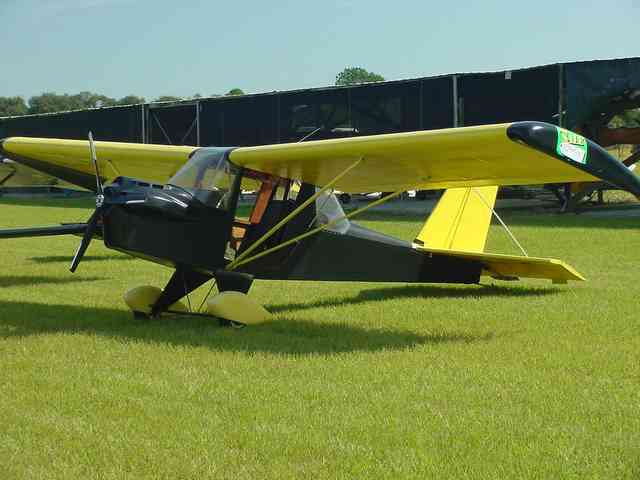
Hi-Max single place all wood construction ultralight aircraft.
|
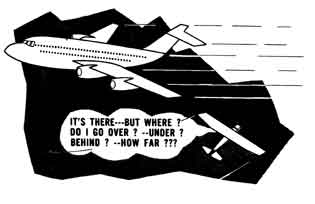
|
Advisory Circular
Aircraft Wake Turbulence
AC NO: 90-23E
Date: October 1, 1991
Initiated by: AFS-430
 U.S. Department of Transportation U.S. Department of Transportation
Federal Aviation Administration
|
- PURPOSE.
This advisory circular (AC) is intended to alert
pilots to the hazards of aircraft wake turbulence and recommends
related operational procedures.
- CANCELLATION.
AC 90-23D, Aircraft Wake Turbulence, dated
12/15/72.
- INTRODUCTION.
Every aircraft in flight generates a wake.
Historically, when pilots encountered this wake in flight, the
disturbance was attributed to "prop wash." It is known, however,
that this disturbance is caused by a pair of counter rotating
vortices trailing from the wing tips. The vortices from large
aircraft pose problems to encountering aircraft. For instance,
the wake of these aircraft can impose rolling moments exceeding
the roll control capability of some aircraft. Further,
turbulence generated within the vortices, if encountered at close
range, can damage aircraft components and equipment and cause
personal injuries. The pilot must learn to envision the location
of the vortex wake generated by large aircraft and adjust his
flight path accordingly.
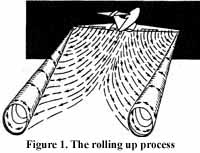
- VORTEX GENERATION.
Lift is generated by the creation of a pressure differential over the wing surfaces. The lowest
pressure occurs over the upper wing surface and the highest
pressure under the wing. This pressure differential triggers the
rollup of the airflow aft of the wing resulting in swirling air
masses trailing downstream of the wingtips. After the rollup is
completed, the wake consists of two counterrotating cylindrical
vortices (see figure 1). Most of the energy is within a few feet
of the center of each vortex, but pilots should avoid a region
within about 100 feet of the vortex core.
- VORTEX STRENGTH.
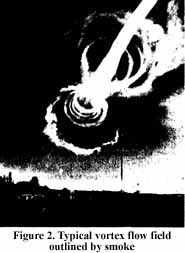 The strength of the vortex is governed by
the weight, speed, and shape of the wing of the generating
aircraft. The vortex characteristics of any given aircraft can
also be changed by extension of flaps or other wing configuring
devices. However, as the basic factor is weight, the vortex
strength increases proportionately with increase in aircraft
operating weight. Peak vortex tangential speeds up to almost 300
feet per second have been recorded. The greatest vortex strength
occurs when the generating aircraft is heavy-clean-slow. Figure
2 shows smoke visualization of a vortex photographed during early
smoke tower fly-by tests.
The strength of the vortex is governed by
the weight, speed, and shape of the wing of the generating
aircraft. The vortex characteristics of any given aircraft can
also be changed by extension of flaps or other wing configuring
devices. However, as the basic factor is weight, the vortex
strength increases proportionately with increase in aircraft
operating weight. Peak vortex tangential speeds up to almost 300
feet per second have been recorded. The greatest vortex strength
occurs when the generating aircraft is heavy-clean-slow. Figure
2 shows smoke visualization of a vortex photographed during early
smoke tower fly-by tests.
- INDUCED ROLL.
- In rare instances, a wake encounter could cause in-
flight structural damage of catastrophic proportions. However,
the usual hazard is associated with induced rolling moments which
can exceed the rolling capability of the encountering aircraft.
In flight experiments, aircraft have been intentionally flown
directly up trailing vortex cores of large aircraft. It was
shown that the capability of an aircraft to counteract the roll
imposed by the wake vortex primarily depends on the wing span and
counter-control responsiveness of the encountering aircraft.
- Counter-control is usually effective and induced roll
minimal in cases where the wing span and ailerons of the
encountering aircraft extend beyond the rotational flow field of
the vortex. It is more difficult for aircraft with short wing
span (relative to the generating aircraft) to counter the imposed
roll induced by vortex flow. Pilots of short span aircraft, even
of the high performance type, must be especially alert to vortex
encounters. The wake of larger aircraft requires the respect of
all pilots. (See figures 3 and 4.)
- VORTEX BEHAVIOR.
Trailing vortices have certain behavioral
characteristics which can help a pilot visualize the wake
location and thereby take avoidance precautions.
 Vortices are generated from the moment aircraft leave
the ground, since trailing vortices are a by-product of wing
lift. Prior to takeoff or landing, pilots should note the
rotation or touchdown point of the preceding aircraft. (See
figure 5.) Vortices are generated from the moment aircraft leave
the ground, since trailing vortices are a by-product of wing
lift. Prior to takeoff or landing, pilots should note the
rotation or touchdown point of the preceding aircraft. (See
figure 5.)
- The vortex circulation is outward, upward and around the
wing tips when viewed from either ahead or behind the aircraft.
Tests with large aircraft have shown that the vortices remain
spaced a bit less than a wing span apart drifting with the wind,
at altitudes greater than a wing span from the ground. In view
of this, if persistent vortex turbulence is encountered, a slight
change of altitude and lateral position (preferably upwind) will
provide a flight path clear of the turbulence.
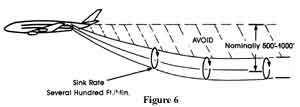 Flight tests have shown that the vortices from larger
(transport category) aircraft sink at a rate of several hundred
feet per minute, slowing their descent and diminishing in
strength with time and distance behind the generating aircraft.
Atmospheric turbulence hastens breakup. Pilots should fly at or
above the preceding aircraft's flightpath, altering course as
necessary to avoid the area behind and below the generating
aircraft. However, vertical separation of 1,000 feet may be
considered safe. (See figure 6.) Flight tests have shown that the vortices from larger
(transport category) aircraft sink at a rate of several hundred
feet per minute, slowing their descent and diminishing in
strength with time and distance behind the generating aircraft.
Atmospheric turbulence hastens breakup. Pilots should fly at or
above the preceding aircraft's flightpath, altering course as
necessary to avoid the area behind and below the generating
aircraft. However, vertical separation of 1,000 feet may be
considered safe. (See figure 6.)
- When the vortices of larger aircraft sink close to the
ground (within 100 to 200 feet), they tend to move laterally over
the ground at a speed of 2 or 3 knots. (Figure 7.)
- A crosswind will decrease the lateral movement of the
upwind vortex and increase the movement of the downwind vortex
(Figure 8). Thus, a light wind with a cross-runway component of
1 to 5 knots (depending on conditions) could result in the upwind
vortex remaining in the touchdown zone for a period of time
(figure 9) and hasten the drift of the downwind vortex toward
another runway. Similarly, a tailwind condition can move the
vortices of the preceding aircraft forward into the touchdown
zone. The light quartering tailwind requires maximum caution.
Pilots should be alert to large aircraft upwind from their
approach and takeoff flightpaths.
-
OPERATIONAL PROBLEM AREAS.
A wake encounter is not
necessarily hazardous. It can be one or more jolts with varying
severity depending upon the direction of the encounter, weight of
the generating aircraft, size of the encountering aircraft,
distance from the generating aircraft, and point of vortex
encounter. The probability of induced roll increases when the
encountering aircraft's heading is generally aligned or parallel
with the flightpath of the generating aircraft. Avoid the area
below and behind the generating aircraft, especially at low
altitude where even a momentary wake encounter could be
hazardous. Pilots should be particularly alert in calm wind
conditions and situations where the vortices could:
- Remain in the touchdown area.
- Drift from aircraft operating on a nearby runway.
- Sink into takeoff or landing path from a crossing
runway.
- Sink into the traffic patterns from other airport
operations.
- Sink into the flight path of VFR flights operating at
the hemispheric altitudes 500 feet below.
- Pilots of all aircraft should visualize the location of
the vortex trail behind large aircraft and use proper vortex
avoidance procedures to achieve safe operation. It is equally
important that pilots of larger aircraft plan or adjust their
flight paths to minimize vortex exposure to other aircraft.
- VORTEX AVOIDANCE PROCEDURES.
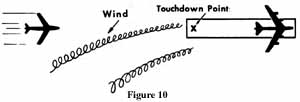 Under certain conditions,
airport traffic controllers apply procedures for separating
aircraft operating under Instrument Flight Rules. The
controllers will also provide to VFR aircraft, with whom they are
in communication and which in the tower's opinion may be
adversely affected by wake turbulence from a larger aircraft, the
position, altitude and direction of flight of larger aircraft
followed by the phrase "caution - wake turbulence." Whether or
not a warning has been given, however, the pilot is expected to
adjust his/her operations and flightpath as necessary to preclude
serious wake encounters. The following vortex avoidance
procedures are recommended for the situation shown:
Under certain conditions,
airport traffic controllers apply procedures for separating
aircraft operating under Instrument Flight Rules. The
controllers will also provide to VFR aircraft, with whom they are
in communication and which in the tower's opinion may be
adversely affected by wake turbulence from a larger aircraft, the
position, altitude and direction of flight of larger aircraft
followed by the phrase "caution - wake turbulence." Whether or
not a warning has been given, however, the pilot is expected to
adjust his/her operations and flightpath as necessary to preclude
serious wake encounters. The following vortex avoidance
procedures are recommended for the situation shown:
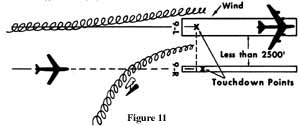 When landing behind a larger aircraft - same runway
(figure 10), stay at or above the large aircraft's final approach
flight path -- note touchdown point -- land beyond it.
When landing behind a larger aircraft - same runway
(figure 10), stay at or above the large aircraft's final approach
flight path -- note touchdown point -- land beyond it.
- When landing behind a larger aircraft - when parallel
runway is closer than 2,500 feet (figure 11), consider possible
vortex drift onto your runway. If you have visual contact with
the larger aircraft landing on the parallel runway, whenever
possible, stay at or above the large aircraft's final approach
flightpath -- note his touchdown point.
- When landing behind a larger aircraft - crossing runway
(figure 12), cross above the larger aircraft's flightpath.
- When landing behind a departing larger aircraft - same
runway (figure 13), note larger aircraft's rotation point -- land
well prior to rotation point.
- When landing behind a departing larger aircraft -
crossing runway, note larger aircraft's rotation point -- if past
the intersection -- continue the approach -- land prior to the
intersection (figure 14). If larger aircraft rotates prior to
the intersection, avoid flight below the larger aircraft's
flightpath. Abandon the approach unless a landing is ensured
well before reaching the intersection (figure 15).
- When departing behind a larger aircraft: Note larger
aircraft's rotation point -- rotate prior to larger aircraft's
rotation point -- continue climb above the larger aircraft's
climb path until turning clear of his wake (Figure 16). Avoid
subsequent headings which will cross below and behind
aircraft (figure 17). Be alert for any critical takeoff
situation which could lead to a vortex encounter.
- Intersection takeoffs - same runway, be alert to
adjacent large aircraft operations particularly upwind of your
runway. If intersection takeoff clearance is received, avoid
subsequent heading which will cross below a larger aircraft's
path.
- Departing or landing after a larger aircraft executing a
low missed approach or touch-and-go landing. Because vortices
settle and move laterally near the ground, the vortex hazard may
exist along the runway and in your flight path after a larger
aircraft has executed a low missed approach or a touch-and-go
landing, particularly in light quartering wind conditions. You
should assure that an interval of at least 2 minutes has elapsed
before your takeoff or landing.
- En route VFR - (1,000-foot altitude plus 500 feet).
Avoid flight below and behind a larger aircraft's path. If a
larger aircraft is observed above on the same track (meeting or
overtaking), adjust your position laterally, preferably upwind.
- HELICOPTERS.
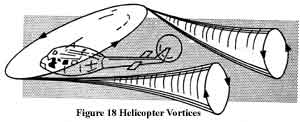 A hovering helicopter generates a downwash
from its main rotor(s) similar to the "prop wash" of a
conventional aircraft. However, in forward flight, this energy
is transformed into a pair of strong, high-speed trailing
vortices similar to wing-tip vortices of larger fixed-wing
aircraft. Pilots should avoid helicopter vortices since
helicopter forward flight airspeeds are often very low which
generate exceptionally strong vortices (figure 18).
A hovering helicopter generates a downwash
from its main rotor(s) similar to the "prop wash" of a
conventional aircraft. However, in forward flight, this energy
is transformed into a pair of strong, high-speed trailing
vortices similar to wing-tip vortices of larger fixed-wing
aircraft. Pilots should avoid helicopter vortices since
helicopter forward flight airspeeds are often very low which
generate exceptionally strong vortices (figure 18).
- JET ENGINE EXHAUST
.
During ground operations, jet engine
blast (thrust stream turbulence) can cause damage and upsets if
encountered at close range. Exhaust velocity versus distance
studies at various thrust levels have shown a need for light
aircraft to maintain an adequate separation during ground
operations (figure 19).
-
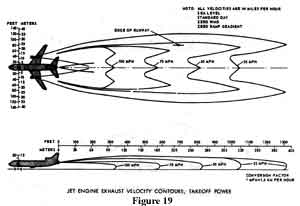 Engine exhaust velocities, generated by larger jet
aircraft during ground operations and initial takeoff roll,
dictate the desirability of lighter aircraft awaiting takeoff to
hold well back of the runway edge at the taxiway hold line.
Also, it is desirable to align the aircraft to face any possible
jet engine blast effects. Additionally, in the course of running
up engines and taxiing on the ground, pilots of larger aircraft
should consider the effects of their jet blasts on other
aircraft, vehicles, and maintenance and servicing equipment. An
illustration of exhaust velocities behind a typical "wide-body"
or jumbo jet is shown in figure 19.
Engine exhaust velocities, generated by larger jet
aircraft during ground operations and initial takeoff roll,
dictate the desirability of lighter aircraft awaiting takeoff to
hold well back of the runway edge at the taxiway hold line.
Also, it is desirable to align the aircraft to face any possible
jet engine blast effects. Additionally, in the course of running
up engines and taxiing on the ground, pilots of larger aircraft
should consider the effects of their jet blasts on other
aircraft, vehicles, and maintenance and servicing equipment. An
illustration of exhaust velocities behind a typical "wide-body"
or jumbo jet is shown in figure 19.
- The Federal Aviation Administration has established
standards for the location of runway hold lines. For example,
runway intersection hold short lines are established 250 feet
from the runway centerline for precision approach runways served
by approach category C and D aircraft. For runways served by
aircraft with wingspans over 171 feet, such as the B-747, taxiway
hold lines are 280 feet from the centerline of precision approach
runways. These hold line distances increases slightly with an
increase in field elevation.
- PILOT RESPONSIBILITY.
Government and industry groups are
making concerted efforts to minimize or eliminate the hazards of
trailing vortices. However, the flight disciplines necessary to
ensure vortex avoidance during visual operations must be
exercised by the pilot. Vortex visualization and avoidance
procedures should be exercised by the pilot using the same degree
of concern as in collision avoidance since vortex encounters
frequently can be as dangerous as collisions.
- Pilots are reminded that in operations conducted behind
all aircraft, acceptance from Air Traffic Control of traffic
information, instructions to follow an aircraft, or the
acceptance of a visual approach clearance, is an acknowledgment
that the pilot will ensure safe takeoff and landing intervals and
accepts the responsibility of providing his own wake turbulence
separation.
- For VFR departures behind heavy aircraft, air traffic
controllers are required to use at least a 2-minute separation
interval unless a pilot has initiated a request to deviate from
the 2-minute interval and has indicated acceptance of
responsibility for maneuvering his aircraft so as to avoid the
wake turbulence hazard.
|
Operational Tips for Light Aircraft
How to Avoid Vortex Wake
- Lift Off Short of Large Aircraft Rotation Point.
- Land Well Beyond Large Aircraft Touchdown Point.
- Pass Over Flight Path of Large Aircraft, or At Least 1000' Under.
- Stay to Windward of Large Aircraft Flight Paths.
- Keep Alert, Especially on Calm Days When Vortices Persist Longest.
|
David S. Potter
Acting Director, Flight Standards Service
|
|
|
|
1 2 3 4 5 6 7 8 9 10 11 12 13 14 15 16 17 18 19 20 21 22 23 24 25 26 27 28
Index for this section. |
|




 The strength of the vortex is governed by
the weight, speed, and shape of the wing of the generating
aircraft. The vortex characteristics of any given aircraft can
also be changed by extension of flaps or other wing configuring
devices. However, as the basic factor is weight, the vortex
strength increases proportionately with increase in aircraft
operating weight. Peak vortex tangential speeds up to almost 300
feet per second have been recorded. The greatest vortex strength
occurs when the generating aircraft is heavy-clean-slow. Figure
2 shows smoke visualization of a vortex photographed during early
smoke tower fly-by tests.
The strength of the vortex is governed by
the weight, speed, and shape of the wing of the generating
aircraft. The vortex characteristics of any given aircraft can
also be changed by extension of flaps or other wing configuring
devices. However, as the basic factor is weight, the vortex
strength increases proportionately with increase in aircraft
operating weight. Peak vortex tangential speeds up to almost 300
feet per second have been recorded. The greatest vortex strength
occurs when the generating aircraft is heavy-clean-slow. Figure
2 shows smoke visualization of a vortex photographed during early
smoke tower fly-by tests.
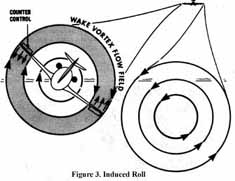
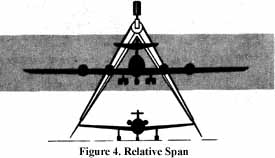
 Vortices are generated from the moment aircraft leave
the ground, since trailing vortices are a by-product of wing
lift. Prior to takeoff or landing, pilots should note the
rotation or touchdown point of the preceding aircraft. (See
figure 5.)
Vortices are generated from the moment aircraft leave
the ground, since trailing vortices are a by-product of wing
lift. Prior to takeoff or landing, pilots should note the
rotation or touchdown point of the preceding aircraft. (See
figure 5.) Flight tests have shown that the vortices from larger
(transport category) aircraft sink at a rate of several hundred
feet per minute, slowing their descent and diminishing in
strength with time and distance behind the generating aircraft.
Atmospheric turbulence hastens breakup. Pilots should fly at or
above the preceding aircraft's flightpath, altering course as
necessary to avoid the area behind and below the generating
aircraft. However, vertical separation of 1,000 feet may be
considered safe. (See figure 6.)
Flight tests have shown that the vortices from larger
(transport category) aircraft sink at a rate of several hundred
feet per minute, slowing their descent and diminishing in
strength with time and distance behind the generating aircraft.
Atmospheric turbulence hastens breakup. Pilots should fly at or
above the preceding aircraft's flightpath, altering course as
necessary to avoid the area behind and below the generating
aircraft. However, vertical separation of 1,000 feet may be
considered safe. (See figure 6.)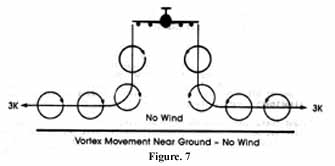
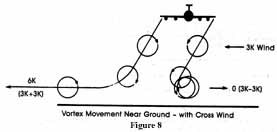

 Under certain conditions,
airport traffic controllers apply procedures for separating
aircraft operating under Instrument Flight Rules. The
controllers will also provide to VFR aircraft, with whom they are
in communication and which in the tower's opinion may be
adversely affected by wake turbulence from a larger aircraft, the
position, altitude and direction of flight of larger aircraft
followed by the phrase "caution - wake turbulence." Whether or
not a warning has been given, however, the pilot is expected to
adjust his/her operations and flightpath as necessary to preclude
serious wake encounters. The following vortex avoidance
procedures are recommended for the situation shown:
Under certain conditions,
airport traffic controllers apply procedures for separating
aircraft operating under Instrument Flight Rules. The
controllers will also provide to VFR aircraft, with whom they are
in communication and which in the tower's opinion may be
adversely affected by wake turbulence from a larger aircraft, the
position, altitude and direction of flight of larger aircraft
followed by the phrase "caution - wake turbulence." Whether or
not a warning has been given, however, the pilot is expected to
adjust his/her operations and flightpath as necessary to preclude
serious wake encounters. The following vortex avoidance
procedures are recommended for the situation shown:
 When landing behind a larger aircraft - same runway
(figure 10), stay at or above the large aircraft's final approach
flight path -- note touchdown point -- land beyond it.
When landing behind a larger aircraft - same runway
(figure 10), stay at or above the large aircraft's final approach
flight path -- note touchdown point -- land beyond it.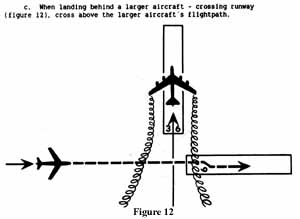
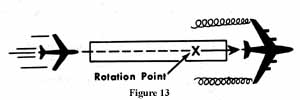
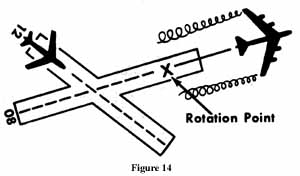
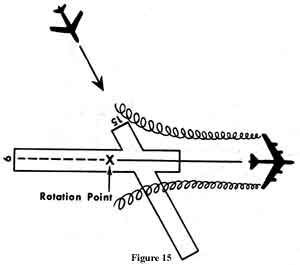

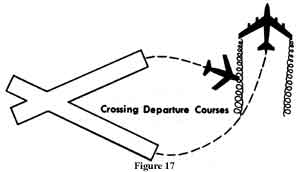
 A hovering helicopter generates a downwash
from its main rotor(s) similar to the "prop wash" of a
conventional aircraft. However, in forward flight, this energy
is transformed into a pair of strong, high-speed trailing
vortices similar to wing-tip vortices of larger fixed-wing
aircraft. Pilots should avoid helicopter vortices since
helicopter forward flight airspeeds are often very low which
generate exceptionally strong vortices (figure 18).
A hovering helicopter generates a downwash
from its main rotor(s) similar to the "prop wash" of a
conventional aircraft. However, in forward flight, this energy
is transformed into a pair of strong, high-speed trailing
vortices similar to wing-tip vortices of larger fixed-wing
aircraft. Pilots should avoid helicopter vortices since
helicopter forward flight airspeeds are often very low which
generate exceptionally strong vortices (figure 18).
 Engine exhaust velocities, generated by larger jet
aircraft during ground operations and initial takeoff roll,
dictate the desirability of lighter aircraft awaiting takeoff to
hold well back of the runway edge at the taxiway hold line.
Also, it is desirable to align the aircraft to face any possible
jet engine blast effects. Additionally, in the course of running
up engines and taxiing on the ground, pilots of larger aircraft
should consider the effects of their jet blasts on other
aircraft, vehicles, and maintenance and servicing equipment. An
illustration of exhaust velocities behind a typical "wide-body"
or jumbo jet is shown in figure 19.
Engine exhaust velocities, generated by larger jet
aircraft during ground operations and initial takeoff roll,
dictate the desirability of lighter aircraft awaiting takeoff to
hold well back of the runway edge at the taxiway hold line.
Also, it is desirable to align the aircraft to face any possible
jet engine blast effects. Additionally, in the course of running
up engines and taxiing on the ground, pilots of larger aircraft
should consider the effects of their jet blasts on other
aircraft, vehicles, and maintenance and servicing equipment. An
illustration of exhaust velocities behind a typical "wide-body"
or jumbo jet is shown in figure 19.